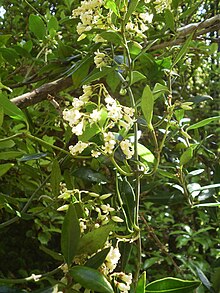|
Parsonsia heterophylla
Parsonsia heterophylla, commonly called New Zealand jasmine or kaihua, is a climbing plant endemic to New Zealand.[1] It was first described by Alan Cunningham in 1839.[2][3] The name heterophylla comes from the differing leaf shapes that can be seen in seedlings and juvenile plants of the species.[4] Heterophylla means varied leaves, from the Greek words heteros and phullon.[5] Synonyms for this species include Parsonsia albiflora Raoul[2][6] and Parsonsia macrocarpa Colenso.[2][7] It can also be described as "the varied-leaved Parsonsia".[8] There are 40 species of Parsonsia found in Asia, Australasia and the Pacific. P. heterophylla is one of two endemic Parsonsia species found in New Zealand.[9] It is more robust and has bigger flowers than its close relative, Parsonsia capsularis, which is also known as akakiore or small Māori jasmine.[10] Parsonsia variabilis Lindl. is listed as a synonym by the New Zealand Plant Conservation Network.[5] However, IPNI[11] and Plants of the World online[12] list Parsonsia variabilis as a synonym of Parsonsia capsularis. Description The flowers of P. heterophylla are "white, scented, and tubular with anthers hidden within the tube."[9] This species has also been observed rarely to have yellow flowers.[13] They appear in many-flowered, fairly compact clusters on the plant.[13] The flowers are small, each usually up to 8mm in size.[10] The flowers are often described for their peculiar scent.[1] Often seen draped over the tops of tall trees, the flowers are more recognisable by their scent than their appearance.[9] The fruit of P. heterophylla is a long, narrow pod that opens to release tufted seeds.[9] These seeds pods are around 15 cm long.[10] Each pod holds numerous seeds, and each one is tipped with a tuft of silky hairs.[4] The two-valved pod opens from the tip downwards, bending outwards and raising seeds up so that their tufts can be caught by the wind.[14] The fruit pods start green, turning to brown and then after the seeds have been dispersed, the dry, empty pods hang a long time on the plant.[4]  The leaves of P. heterophylla are variable in size and shape, both in all stages of its life.[15] The leaves of seedlings and juvenile plants are largely diverse, and a range of small and round, long and narrow and irregularly shaped leaves can all be found mixed on the same plant.[13] In adults, the leaves are described as "opposite, rather shiny and rather dark green from above, much paler underneath, more or less smooth-edge but often somewhat wavy edged, more than 1 cm wide, often 2, 3, or 4 cm wide and up to 10cm long".[13] While the leaves of adult plants are usually shorter and broader than in juveniles, they are still variable in shape.[15] The leaf types can narrowly be defined as small round, long narrow and moderately broad and oblong.[16]  The twining stems of P. heterophylla are often tightly wrapped around host stems and are described as softly woody and flexible.[13] In older plants, the stem is woody towards the base.[15] Each stem is as thick as a quill and shining.[8] This branching climber can reach up to 10 metres tall by climbing up any plant within reach.[15] DistributionP. heterophylla is an indigenous or endemic species of New Zealand, meaning that it is not found anywhere else in the world.[17] Its presence has been recorded in the North Island, South Island, Three Kings Islands and Stewart Island.[15] It is commonly found across the country in lowland or low montane forest.[9] Its preferred habitat is forest margins and clearings in coastal scrub patches.[10] It has been observed to grow side by side with its close relative Parsonsia capsularis in the Banks Peninsula, where hybrids are sometimes encountered.[13] Life cycleThere is little information available on the timeline and life cycle of this species. This plant flowers from September to March, followed by seed pods from February.[1] Seeds are dispersed then by the wind.[14] For planting P. heterophylla in gardens, the optimal time to collect seeds is between February and April.[18] InteractionsP. heterophylla twine their young stems around other plants in order and grow and climb towards the sunlight.[10] P. heterophylla is a host plant to a number of invertebrate species, including beetles, wasps, moths, butterflies, grasshoppers and sucking bugs.[19] The larvae of the moth Stigmella kaimanua feed on the leaves of P. heterophylla.[20] It also attracts the rare New Zealand ribbonwood aphid or Paradoxaphis plagianthi.[21] The sweet-scented flowers of P. heterophylla are attractive to night-flying moths.[15] The nectar of P. heterophylla is eaten by the New Zealand bellbird or korimako.[22] Further informationP. heterophylla's current conservation status is not threatened, according to the Department of Conservation.[5] The flowers of P. heterophylla were historically often bound by Māori to the perches of bird-traps as a lure.[23] References
é |
||||||||||||||||||||||||||||||||

